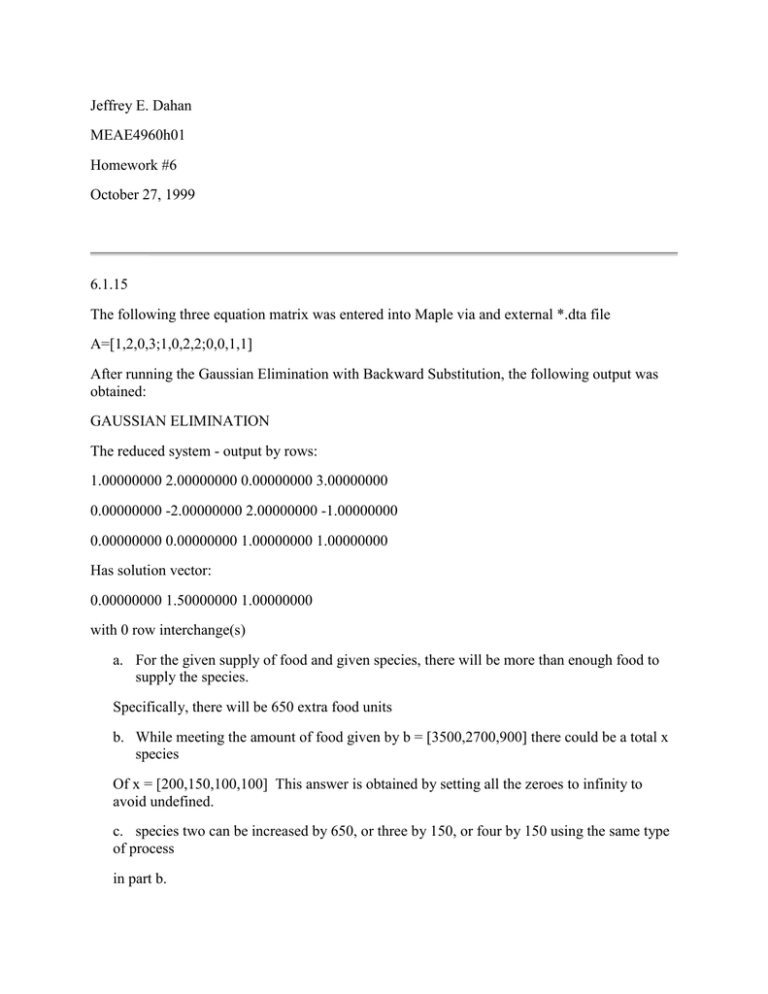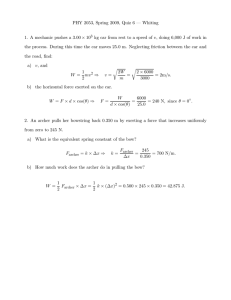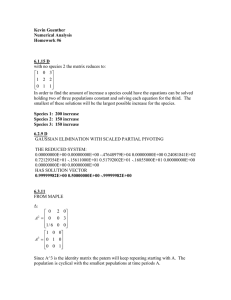Jeffrey E. Dahan MEAE4960h01 Homework #6 October 27, 1999
advertisement

Jeffrey E. Dahan MEAE4960h01 Homework #6 October 27, 1999 6.1.15 The following three equation matrix was entered into Maple via and external *.dta file A=[1,2,0,3;1,0,2,2;0,0,1,1] After running the Gaussian Elimination with Backward Substitution, the following output was obtained: GAUSSIAN ELIMINATION The reduced system - output by rows: 1.00000000 2.00000000 0.00000000 3.00000000 0.00000000 -2.00000000 2.00000000 -1.00000000 0.00000000 0.00000000 1.00000000 1.00000000 Has solution vector: 0.00000000 1.50000000 1.00000000 with 0 row interchange(s) a. For the given supply of food and given species, there will be more than enough food to supply the species. Specifically, there will be 650 extra food units b. While meeting the amount of food given by b = [3500,2700,900] there could be a total x species Of x = [200,150,100,100] This answer is obtained by setting all the zeroes to infinity to avoid undefined. c. species two can be increased by 650, or three by 150, or four by 150 using the same type of process in part b. d. species three could be increased by 150, or four by 150. 6.2.9d The Matrix A has been entered in via a *.dta file and is as follows: 3.333 15920 10.333 7953 2.222 16.71 9.612 0.965 5.179 -1.6855 2.714 -1.5611 The Matrix is computed using the Guassian Elimination with scaled partial pivoting and obtains the Following output from Maple: GAUSSIAN ELIMINATION WITH SCALED PARTIAL PIVOTING The reduced system - output by rows: 0.00000000 0.00000000 -4764.95347400 0.00000000 24.08155723 7.21293460 -1.56110000 5.17900000 -1.68550000 Has solution vector: .99991467 .50000001 -.99998028 with 1 row interchange(s) The rows have been logically re-ordered to: 321 The actual solutions are compared to the results of computing the matrix using the Guassian Elimination With scaled partial pivoting: Algorithm Exact Difference 0.99991467 1.00000000 0.00008533 0.50000001 0.50000000 0.00000001 -0.99998082 -1.00000000 0.00001918 Scaled Partial Pivoting is a highly accurate alternative to manually obtaining the actual answers (if possible). 6.3.11 The study of a female basis on a probabilistic basis reveals that A = [0 0 6, .5 0 0, 0 1/3 0] a. A2 is constructed by doing matrix multiplication for A*A to equal [0 2 0, 0 0 3, 1/6 0 0] A3 is constructed by A2*A to equal [1 0 0, 0 1 0, 0 0 1] Another iteration is carried out to determine the trend: A4 = [0 0 6, 1/2 0 0, 0 1/3 0] which is identical to a. Therefore, the cycle repeats itself every four years. b. for 6000 beetles, the results will simply be scaled by 6000, which is accurate of scaling a matrix: Age 1 Age 2 Age 3 1st year 6000 6000 6000 2nd year 36000 3000 2000 3rd year 12000 18000 1000 4th year 6000 6000 6000 c. the inverse matrix A-1 is found to be [0 2 0, 0 0 3, 1/6 0 0], which is identical to A2. 6.5.3a The initial matrix [2 -1 -1, 3 3 9, 3 3 5] using LU factorization yeilds L = [1 0 0, 1.5 1 0, 1.5 1 1] using diagonal ones and everything below, and U = [2 -.5 .5, 0 4.5 1.66667, 0 0 -4] using the upper triangle Then, Ly=b is used to determine the y's. y = [-1, 1.5, 4] Next, knowing Ux=y, backwards substitution can be used to find x: x = [4.5 9 -1]





